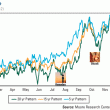by Liz Ann Sonders, Senior Vice President, Chief Investment Strategist, Charles Schwab & Co., Inc.
Key Points
- Frothy sentiment suggests the market may be poised for a consolidation of gains and/or pullback.
- But neither valuation nor weak volume should be major concerns.
- Any seasonal/sentiment-related weakness is likely in the context of a secular bull market that isn't yet over.
We don't make it a habit to try to time the market in the short-term, but given elevated optimistic sentiment, seasonal tendencies, and some technical deterioration within the stock market, I think the market has become vulnerable again to a pullback. But my optimism that we are in a secular bull market has not been dented; and below you'll read some interesting historical tidbits that help frame that longer-term optimism.
Sentiment a tad frothy
As you can see in the chart below, NDR's Crowd Sentiment Poll is in "extreme optimism" territory; portending potential short-term trouble for the market.
Optimistic Sentiment Remains Elevated
Source: FactSet, Ned Davis Research (NDR), Inc. (Further distribution prohibited without prior permission. Copyright 2013 (c) Ned Davis Research, Inc. All rights reserved.), as of August 6, 2013.
Do notice though how quickly sentiment has reversed in the past couple of years. This year's 5.8% selloff by the S&P 500 caused sentiment to do a 180 in very short order—from extreme optimism to near-extreme pessimism, before rebounding alongside the market's summer rally. We have seen similar quick and large swings in sentiment by the American Association of Individual Investors survey, a component of NDR's proxy.
Anecdotally, I still sense a tremendous amount of skepticism about the market by individual investors with whom I speak at the many events at which I've spoken this year. In addition to questions about the coming effects of Fed tapering, two of the most common questions/comments I hear are about valuations and the low trading volume of the stock market.
Valuation richer, but not loaded
When investors lament what they believe to be an over-valued market they are often referring to the high historical valuation of the Shiller Cyclically-Adjusted P/E (CAPE). I recently dissected Shiller's model and provided my perspective on why it's somewhat flawed and certainly should not be used as a market timing tool. But looking at more traditional P/E ratios, I would argue the market is no worse than fairly valued.
On a forward P/E basis, the market remains quite inexpensive at 15 relative to the long-term average since 1990 of over 18, as you can see below. However, valuation purists like to point out the uncertainty inherent in valuing stocks on prospective earnings given analysts' often-questionable ability to accurately forecast them.
Forward P/E Still Cheap
Source: Factset, Standard & Poor's, as of August 9, 2013.
So, let's look at the trailing P/E; on which basis the market has become a little richer at just under 17, as you can see below. The market remains below the post-1990 average of 19; but is above the average of a little more than 15 over the entire history of the S&P 500.
Trailing P/E Slightly Less Cheap
Source: Factset, Standard & Poor's, as of August 9, 2013.
Valuation expansion has been key
This is where it gets interesting though. Although I believe the market is ripe for a period of consolidation of recent gains, too many investors become skittish about the market upon an acceleration of P/Es to above the norm. As you can see in the table below, once a period of valuation expansion begins, it typically doesn't end until P/Es are well above the long-term norm. The table from Bespoke Investment Group (B.I.G.) lists S&P bull markets since 1928 that have lasted a year or more.
For every S&P bull market in history (going back to 1928), BIG listed the trailing P/E at the start and end of each, as well as the total percentage change. The market traded at an average multiple of 11 at the start of bull markets and over 18 at the end. Therefore, while the market was trading at an elevated multiple when the current bull market began, it is still below where it was historically when the market peaked (over 18).
Source: Bespoke Investment Group, LLC (B.I.G.), as of August 9, 2013.
In fact, of the 13 prior bull markets listed above, there have only been four where the market peaked at a lower multiple than the current level. If the S&P were to peak in this bull market at a similar valuation to the average bull market, it would peak at over 1800.
We are indeed in a period during which valuations have been expanding; with most of the macro conditions still in place that support valuation expansion, notably low inflation. According to B.I.G., practically all of the multiple expansion that occurred during bull markets took place in the first and third trimester of the bull market. The average multiple expansion during the first trimester was 35%. In the second trimester, multiples historically shrunk by just over 4%. And, in the last trimester, multiples expanded by an average of 27%.
Many investors have expressed concern about the apparent disconnect between slow earnings growth and expanding valuations; when in fact, that's been the norm over the past 60 years. We typically see the largest amount of multiple expansion when earnings growth is slowing, not when it's accelerating; also typical in bull markets' third trimesters. You can see this in the chart below.
Earnings Growth Slowing While Valuations Expanding
Source: ISI Group, Standard & Poor's, as of August 9, 2013.
Since the end of 2010, through the end of June 2013, S&P earnings per share are up about 19% and the P/E has expanded by nearly a full point.
Low volume = higher stock market
Finally, another common question I get from skeptical investors is how I can remain optimistic when the market has been trading on such low trading volume. In fact, market pundits of the more bearish persuasion, consistently lament the rallies that have been on low volume; seemingly without bothering to see whether low volume has been a market negative.
Thanks to B.I.G. (again), we can see an interesting volume analysis of the current bull market.
Don't Sweat Low Volume!
Source: Bespoke Investment Group, LLC (B.I.G.), FactSet, as of August 9, 2013.
The chart breaks out performance the current bull market based on days when volume (using the SPY exchange-traded fund as a proxy) has been above and below its 50-day moving average. On a cumulative basis, the S&P would be up nearly 300% if you were only invested on the days when volume was below average. That's nearly double the return of the entire bull market! On the other hand, if you were only invested when volume was above average, you would actually be down 37%. Complain if you'd like, but gains are preferred over volume, no?
Market bears seem never to be short reasons for gloom; but valuation and volume shouldn't be among them. Sentiment? Perhaps, but likely only represents a short-term reason for concern in an otherwise healthy backdrop for stocks in the latter part of this year.















